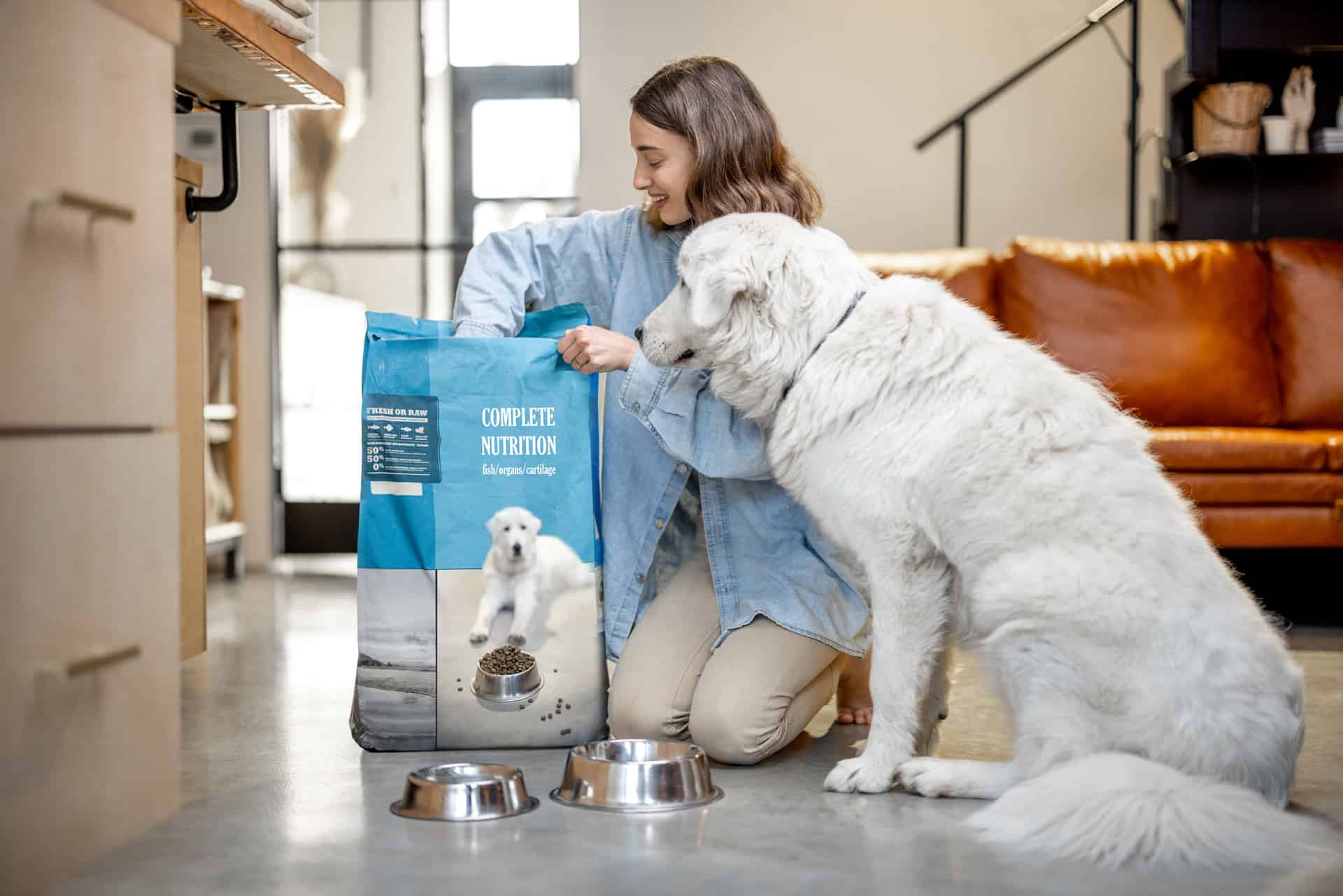Navigating the World of Dog Food: Tips for Making the Right Choice
Deciding on the best dog food can be overwhelming for pet owners. Here are some tips to help:
- Read Labels: Read labels carefully before you buy. Look for high-protein sources like chicken, beef and lamb. Avoid “meat by-products” and “animal digest” as those are not as nutritious.
- No Fillers: Avoid fillers such as corn, wheat and soy. These are hard for dogs to digest and can cause allergies and digestive issues.
- Age & Activity Level: Puppies, adult and senior dogs have different nutritional needs. Choose food tailored to your dog’s age and activity level.
- Speak To Vet: Talk to your vet to get advice on what food is best for your pet.
Pro tip: Focus on quality and nutrition when buying dog food, not just the packaging or marketing tricks.
Understanding Your Dog’s Nutritional Needs
When it comes to your pup’s food, you must understand their exact dietary needs. Different dog breeds and ages need different nutrition. So, research is key! Here are some tips to help you in the world of dog food. Make the best decision for your furry friend!
Age-appropriate food choices
Choosing the right food for your pup is key to keeping them healthy. Here’s what to consider:
Puppies: Protein, fat, and calories are needed for growth. Get puppy-specific food with vitamins and minerals. Don’t give them adult food.
Adult Dogs: When fully grown, switch to adult food. Look for balanced nutrition with protein, fat, and carbs. Avoid high fillers or artificial preservatives.
Senior Dogs: Metabolism slows down, so they may gain weight. Get senior-specific food that’s lower in calories, higher in fiber. Look for food with antioxidants and joint supplements.
Breed-specific dietary requirements
Different dog breeds have different needs for thriving. It’s key to understand these needs before picking their food. Here are some breed-specific ones to consider:
- Small breeds: Tiny dogs need more frequent meals with nutrient-filled food. Look for food with high protein and fat content.
- Large breeds: Big dogs are prone to joint issues. Their diet should include joint-supporting supplements such as glucosamine and chondroitin. Also, the diet of large breed puppies should be slow-growth to avoid bone problems.
- Flat-faced breeds: Pugs and Bulldogs are more likely to be obese and have breathing issues. Give them smaller meals throughout the day with lower-calorie food.
- Active breeds: Active and energetic breeds want more calories and nutrients to keep up their energy. Consider high protein diets with balanced carbs and fats.
- Older breeds: Older dogs have slower metabolism and need fewer calories. Senior dog food with added vitamins and supplements for joints and digestion is ideal.
Health issues and dietary considerations
When it comes to feeding your pup, comprehending their nutritional needs and dietary considerations is key to a healthy life. Here are some tips to make the right choice for your furry buddy:
- Choose a dog food suitable for their age, breed, and size.
- Opt for high-quality food that contains meat, vegetables, and whole grains.
- Avoid dog food with fillers, artificial colors, preservatives, and animal by-products.
- Consult your vet if your pup has any dietary restrictions or health concerns.
- Make sure to provide fresh water all the time.
By following these tips, your pup will stay healthy and happy for years!
Evaluating Dog Food Labels
Read the labels on dog food carefully before buying! Labels show what is inside, how much of each ingredient, and more. Knowing this is very important for picking the right food. In this part, we will explain why it’s important to read the labels, and how to understand them.
Recognizing key ingredients
When you evaluate dog food labels, it’s essential to spot key ingredients that impact your pup’s nutrition intake and wellbeing. Here’s what to look for:
- Protein: The main ingredient should be a quality source of protein e.g. meat, fish or poultry. Avoid generic terms like “meat by-products.”
- Carbohydrates: Look for whole grains, veggies and fruits as sources. Don’t go for filler ingredients like corn and soy.
- Fat: Pick dog food with quality fat sources such as fish oil, chicken fat or flaxseed oil. Skip “animal fat” or “tallow” as they don’t specify the source.
- Vitamins & Minerals: Check the label for essential vitamins and minerals. These include calcium, phosphorus and vitamins A, D, E and K.
Remember, dog food labels can be tricky and manufacturers use marketing words to attract buyers. So, consult your vet and read the labels carefully to make the best choice.
Decoding the guaranteed analysis
Dog food labels can be tricky. But don’t worry, breaking down the guaranteed analysis will help you pick the right food for your pup. Here’s what you need to know:
- Crude Protein: This shows the total protein in a dog food product. Aim for foods with good-quality protein sources like meat, fish, and poultry.
- Crude Fat: This shows the total fat in a dog food product. High-quality fats are essential for healthy skin, coat, and immune system.
- Crude Fiber: This shows the total fiber in a dog food product. It’s important for digestion and weight control.
- Moisture: This shows the water content in a dog food product. Foods with high moisture content can keep your pup hydrated.
Remember, the guaranteed analysis only provides minimum or maximum values. So it’s best to talk to your vet when choosing the right food for your pet.
Identifying filler ingredients to avoid
Filler ingredients are used in pet food as a cheaper option than proper proteins and nutrients. It’s important to spot these fillers and avoid them when looking at dog food labels.
Some common fillers are:
- Corn, wheat, & soy products. These are cheap but dogs don’t process them well, leading to digestion problems.
- Animal by-products. Low-quality proteins like bones, intestines, and beaks.
- Artificial colors, flavors, & preservatives. These chemicals make food appealing, but they can cause allergies and other health problems.
Choose dog food with high-quality proteins like chicken, turkey, beef, or lamb. Look for food free from artificial colors, flavors, and preservatives, plus fruits and veggies like sweet potatoes and blueberries.
Pro tip: Check the ingredient list on dog food labels and don’t be fooled by marketing tactics saying it’s high-quality without evidence.
Types of Dog Food
Picking the best dog food for your pup can be tricky. To help, let’s look at the three main types of food available: wet food, dry food, and raw food. Each type has its own pros and cons. Here’s what to consider when making your selection:
Dry food options
Dry food is a great choice for canine nutrition. There are three options to pick from: kibble, freeze-dried, and dehydrated.
Kibble is popular; it comes in many flavors and is easy to store. Plus, some brands add vitamins and minerals for health.
Freeze-dried food has a long shelf life and doesn’t need to be refrigerated. Perfect for trips with your pup.
Dehydrated food keeps more of the original nutrients and flavor. Making it a tasty and healthy option.
When selecting dry food, consider your dog’s age and size. Check the ingredients, no fillers or by-products. If your pup has dietary needs or health issues, consult a vet.
Wet (canned) food options
Wet (canned) dog food is a great pick for pooches that struggle to chew hard kibble or need extra moisture in their meals. There are a few different types of wet dog food, each with their own advantages and disadvantages.
- Stews and Casseroles: These are made with chunks of meat, veg and gravy. Nutritious and easy to digest.
- Pâtés: A smooth and creamy wet dog food. Dogs with dental issues find it easy to eat. Comes in many flavors and textures.
- Loaf-style: This wet dog food has a texture like bread and is made with meat, veg and grains. Easy to portion out for serving.
When selecting wet dog food, check the label for the nutritional info and use the suggested serving size based on your pup’s weight and level of activity.
Pro tip: Don’t leave wet dog food out for too long as it can go bad quickly. Refrigerate any leftovers for up to three days or freeze for later.
Semi-moist food options
Semi-moist dog food is a type of kibble that’s between dry and wet/canned food. It typically has 15%-30% moisture, making it easier to digest. Here are some of the best semi-moist food options:
- Jerky treats: Protein-rich and great for training & snacking.
- Soft-moist dog food: Chewy and easily digestible, comes in small pieces.
- Freeze-dried or dehydrated food: Popular, made by removing moisture from fresh foods or ingredients and rehydrating.
- Meat rolls: Convenient, high in protein and easy to portion.
Pro tip: Always read the label for quality ingredients, balanced nutrition, and appropriate serving sizes before feeding your pup semi-moist food!
Choosing the Best Dog Food Brand
Choosing dog food for your pup can be tricky. There are so many varieties and brands! To make sure you pick the best one, there are a few things to consider. This article will outline the key points to keep in mind. Remember these tips when selecting a dog food brand.
Researching nutritional quality of popular brands
Researching dog food brands is crucial when picking the best one for your furry friend. Here’s what pet owners can do:
- Check the ingredients list. Look for real meat, vegetables and fruits. Avoid fillers, by-products, artificial preservatives, and colors.
- Check if it has a complete and balanced diet, with all essential nutrients.
- Review the brand’s reputation. Check online reviews and ask your vet.
- Look for certifications from bodies like AAFCO or NRC.
As a pet owner, research and choose a dog food brand that fits your furry friend’s needs and health.
Identifying trusted brands with quality ingredients
Choosing the best dog food brand is key. Analyze the ingredient list and check the reputation of the brand. Here’s how:
- Look for quality sources of protein like chicken, beef, and lamb.
- Avoid brands with meat by-products and fillers such as corn, wheat, or soy.
- Choose brands with high standards for sourcing ingredients and rigorous testing processes.
- Pick ones that have been recommended by vets and have a good reputation with pet owners.
With these tips, you can find trusted dog food brands with great ingredients that meet your dog’s nutritional needs.
Pro Tip: Don’t forget to gradually introduce new brands and flavors – this will help avoid digestive upset.
Understanding the value of premium dog food options
Choosing the best dog food brand? Premium options are crucial. Price tag may be higher, but the benefits make it worth it.
Premium food contains high-quality proteins for better health. Human-grade ingredients and no harmful additives like colors, flavors, or preservatives.
Plus, breed-specific formulas to meet the unique needs of different breeds.
Pro tip: Look for high-quality proteins, avoid artificial additives, and get breed-specific formulas. Consult your vet for your dog’s needs.
Common Dietary Issues and Solutions
As a pet parent, it’s vital to comprehend dietary problems. Certain dog food types can cause health issues in the long-term. Knowing the cause and effect of certain ingredients in dog food and the risks to your pup’s health is a must. Here, we’ll discuss common dietary problems and solutions for navigating the world of dog food.
Allergies and dietary restrictions
Allergies & dietary restrictions can be a challenge when it comes to finding the right food for your pup. But there are solutions!
Identify the source of your pup’s allergies. Common allergens include beef, chicken, soy, & wheat. Then select a dog food without the problem ingredient.
For dogs with dietary restrictions, there are lots of options. These include grain-free, low-fat, and limited ingredient dog foods.
It’s important to talk to your vet to figure out what food is best for your dog’s needs. They can help you choose, identify your pup’s nutritional needs, and give advice on portion control.
When introducing new food, start small. Mix a bit of the new food in with your pup’s current food, and slowly increase the ratio over several days.
Remember to read ingredient lists carefully and to consult with your vet. That way you’ll find the perfect food for your pup’s dietary needs!
Digestive concerns and dietary solutions
Digestive issues in dogs are common and can be due to many factors. But with the right food, you can help improve their health. Here’s how:
- Opt for organic stuff like grains, proteins, and veg.
- Shun fillers and artificial additives.
- Try novel proteins – lamb, duck, or venison – if your pup is allergic to chicken or beef.
- Gradually switch their diet and keep an eye on their response.
- Add probiotics or digestive enzymes as supplements.
- Consult your vet for advice and long-term management.
Pro tip: Pay attention to labels and ask your vet first!
Nutrition-based solutions for skin/coat and dental health.
Good nutrition is a must for keeping a dog’s skin/coat and dental health in check. Here are some nutritionally-based solutions to address common dietary problems:
Skin/Coat Health:
- Feed your pup foods loaded with Omega-3 and Omega-6 fatty acids – like salmon or flaxseed oil. These acids reduce inflammation and support healthy skin.
- Vitamin E can be added to your dog’s diet by feeding them veggies, such as carrots or sweet potatoes.
- Offer your pup a balanced diet of high-quality proteins, carbs and healthy fats to keep up their overall health.
Dental Health:
- Dry dog food is better for dental health than wet food as it scrapes away plaque and tartar when the dog chews.
- Give your dog dental chews or bones designed to clean teeth and freshen breath.
- An enzyme supplement can be added to your pup’s food to limit plaque buildup.
Pro Tip: Knowing your dog’s nutritional needs and providing them with a balanced diet is key for maintaining their overall health and well-being.
Frequently Asked Questions
Q: What should I look for when selecting a dog food brand?
A: Look for high-quality ingredients, including protein sources like chicken, beef, or fish, and whole grains like brown rice and barley. Avoid brands with fillers like corn or wheat.
Q: How do I determine the appropriate amount of food to feed my dog?
A: The recommended amount of food varies based on your dog’s age, weight, and activity level. Consult with your veterinarian to determine a personalized feeding plan.
Q: Are there any harmful ingredients or additives I should avoid when selecting a dog food?
A: Yes, avoid dog foods with artificial preservatives like BHA, BHT, and ethoxyquin, as well as dyes and added sugars.
Q: Can I feed my dog a vegetarian or vegan diet?
A: While it is possible to feed your dog a plant-based diet, it is important to consult with a veterinarian to ensure it is nutritionally balanced and meets your dog’s needs.
Q: Should I choose wet or dry dog food for my pet?
A: Both wet and dry dog food can be nutritionally complete, so the decision ultimately depends on your dog’s individual preference and needs. Wet food may be beneficial for dogs with dental issues, while dry food is often more convenient and longer-lasting.
Q: How can I tell if my dog is allergic to certain ingredients in their food?
A: Symptoms of food allergies in dogs can include itching, skin rash, diarrhea, and vomiting. Consult with a veterinarian if you suspect your dog has a food allergy to determine the underlying cause and the best course of treatment.







